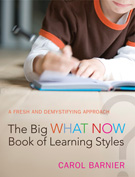I don’t try to review all of the books about homeschooling that are written for parents—there are just too many of them. Instead, I try to concentrate on core curricula as much as possible. However, over the years I’ve talked and written a great deal on learning styles. I’ve even developed my own simplified system for approaching learning styles. But I’ve always explained that there are many different approaches to learning styles, and they all work. The point of it is to tune into what’s happening with our children, to notice how they learn most easily and effectively then teach new concepts using those methods.
In The Big WHAT NOW Book of Learning Styles, Carol Barnier emphasizes that same message—it’s not really important what system you use or what labels you come up with. The importance lies in what you do with the information. To that end, Barnier simplifies down to the three learning modalities--auditory, visual, and kinesthetic--to set the stage. Then she offers lots of concrete suggestions for learning methods you might try for various subject areas. A chapter each is devoted to ideas for spelling, writing (both handwriting and composition), reading, math, history, geography, and science. Another chapter suggests methods to use for review that might be applied with any subject.
Suggestions are identified with icons as to which are most likely to suit which one or more of the three learning modalities. As Barnier points out, despite our best efforts to identify learning styles or modalities and choose corresponding methods, methods that might not seem appropriate might turn out to be the very things that work. So Carol recommends an open approach to experimentation with methods and keeping a journal where you note which methods work and which don’t.
Most of the ideas Barnier presents are more interesting and fun than traditional workbooks, yet most are relatively simple. Some involve setting information to be learned to memorable ditties—she shares many they’ve come up with over the years. Some turn learning into simple games. Many utilize multi-sensory methods of presenting information. However, you don’t need to buy expensive equipment or supplies, since household and standard school supply items will suffice for most activities.
Rather than dump the curriculum you’re using and buying something new, try using some of Barnier’s suggestions to see if you can’t come up with at least a handful of ideas that will make learning easier for your child and less frustrating for you.









